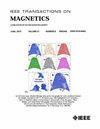Modeling of Permanent Magnet Eddy-Current Coupler Based on Unsupervised Physics-Informed Radial-Based Function Neural Networks
IF 2.1
3区 工程技术
Q3 ENGINEERING, ELECTRICAL & ELECTRONIC
引用次数: 0
Abstract
Physics-informed neural networks (PINNs) have significant potential for modeling and parameter design in engineering field. While most existing PINNs research focuses on fluid mechanics and thermodynamics, few studies explore its application in electromagnetic field modeling of electromagnetic devices. Modeling the permanent magnet eddy-current coupler (PMECC) to predict its performance characteristics based on geometric parameters and material properties is crucial for its design and optimization. An unsupervised modeling method for PMECC based on physics-informed radial basis neural networks (PIRBFNNs) is presented in this work. The modeling and solving of static magnetic field for devices excited by permanent magnets (PMs) is realized, which solves the problem of the traditional PINN fully connected structure with many parameters and difficult training. We use the magnetic vector potential as the solution objective without providing the magnetic field boundary parameters and without labeling data, which is an unsupervised learning paradigm. The magnetic field distribution and performance of the PMECC can be computed using only the structural parameters. The experimental results show that the proposed PIRBFNN method is basically consistent with the results of the finite element numerical method and the analytical method. Additionally, a transfer learning experimental study was conducted to validate the effectiveness of the network components and training methods proposed in this article. The proposed method can, furthermore, be applied to the modeling and analysis of various devices using PM excitations.基于无监督物理信息径向函数神经网络的永磁涡流耦合器建模
物理信息神经网络在工程领域的建模和参数设计方面具有重要的潜力。现有的pin - ns研究大多集中在流体力学和热力学方面,很少有研究探索pin - ns在电磁器件电磁场建模中的应用。基于永磁涡流耦合器的几何参数和材料特性对其进行建模,预测其性能特征,对永磁涡流耦合器的设计和优化具有重要意义。提出了一种基于物理信息径向基神经网络(PIRBFNNs)的PMECC无监督建模方法。实现了永磁体励磁器件静态磁场的建模与求解,解决了传统PINN全连接结构参数多、训练难的问题。我们使用磁矢量势作为解目标,不提供磁场边界参数,也不提供标记数据,这是一种无监督学习范式。仅用结构参数就可以计算出PMECC的磁场分布和性能。实验结果表明,所提出的PIRBFNN方法与有限元数值方法和解析方法的结果基本一致。此外,我们还进行了迁移学习实验研究,以验证本文提出的网络组成部分和训练方法的有效性。此外,所提出的方法可以应用于各种使用PM激励的器件的建模和分析。
本文章由计算机程序翻译,如有差异,请以英文原文为准。
求助全文
约1分钟内获得全文
求助全文
来源期刊

IEEE Transactions on Magnetics
工程技术-工程:电子与电气
CiteScore
4.00
自引率
14.30%
发文量
565
审稿时长
4.1 months
期刊介绍:
Science and technology related to the basic physics and engineering of magnetism, magnetic materials, applied magnetics, magnetic devices, and magnetic data storage. The IEEE Transactions on Magnetics publishes scholarly articles of archival value as well as tutorial expositions and critical reviews of classical subjects and topics of current interest.
 求助内容:
求助内容: 应助结果提醒方式:
应助结果提醒方式:


